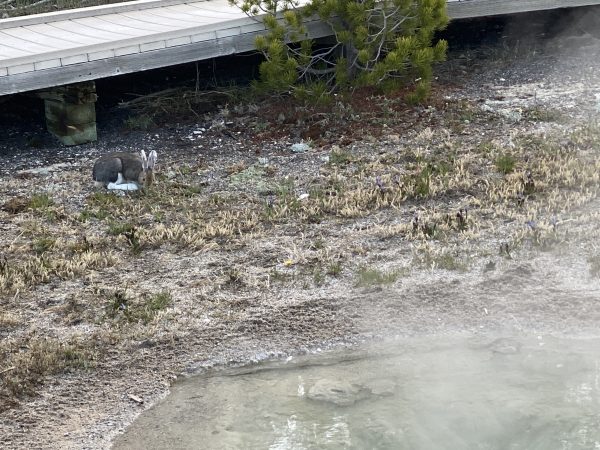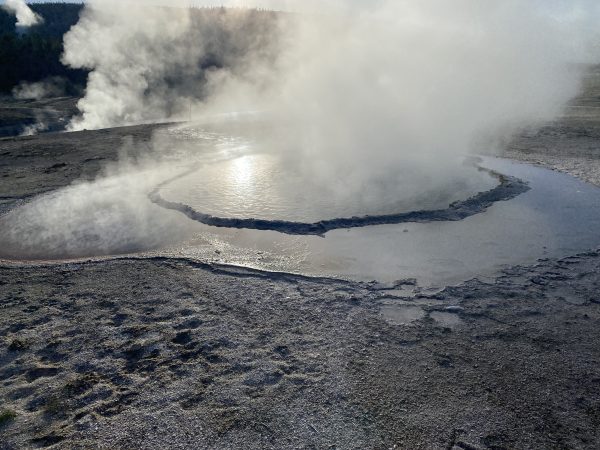Since Grand erupted during Rift's eruption last night, the expected long interval for Grand took place overnight. The first three observed Turban eruption durations were short, around three minutes long. Then we got a long Turban interval, but it wasn't long enough to qualify as a Turban Delay Interval. That Turban duration was a minute longer, as was the next eruption.
Grand finally erupted less than 16 minutes later. When the first burst ended at less than 8-1/2 minutes long, we were pretty sure of a second burst. Backlit by the sun with much of the steam cleared away, it seemed impressively high. And it lasted just over 1/2 a minute, which is short. Despite that, the pool quickly drained and there was no effort at a third burst, and a total duration of about 9m36.
2024-Jun-02:08:13:57 T2C 08:13:50 Vent Ovfl -0m07s 08:13:52 Turban -0m05s 08:13:57 B1 --- d=08m17s 08:16:34 Vent 2m36s 08:22:15 P1 8m17s d=39s 08:22:54 B2 8m56s d=32s 08:23:26 P2 9m28s Vent & Turban continue ΣB=08m49s ΣD=09m28s * * * * * 06:43:55 d=03m10s 07:01:14 Int: 17m19s d=03m09s 07:17:39 Int: 16m25s d=03m00s 07:40:49 Int: 23m10s d=04m13s 07:57:59 Int: 17m10s d=03m50s Turban: 15m52s
Afterwards, in the Sawmill Group Uncertain was splashing. All the conditions looked good for an eruption. Waited a bit, and then suddenly Sawmill started. Despite that, Uncertain continued to splash, and a few minutes later it built into an eruption. This eruption seemed shorter than those I've seen in the past, but that may be due to erupting with Sawmill.
Later went out for the noon radio call for Beehive's Indicator.
In the early afternoon, went out to Grand a bit early, as not sure if the longer intervals due to Rift would still be in effect. Not a super long interval, but still longer than the day prior to Rift erupting. Had to sit through several small showers that were just enough to wet things down.
The first burst from Grand was long enough for a One Burst Eruption, but we were rewarded with a second burst. The pause was less than a half minute, and it looked like Grand's pool was down quite a bit when the bursting restarted. Usually I expect to see sloshing around for a while as the pool rises to near overflow. The second burst then lasted almost long enough to qualify as a Long Second burst, while the Vent & Turban restart took well over twenty minutes.
2024-Jun-02:15:52:49 G2Q 15:52:49 B1 --- d=09m38s 15:53:42 Turban 0m53s 15:56:17 Vent 3m28s 16:02:27 P1 9m38s d=28s 16:02:55 B2 10m06s d=01m07s 16:04:02 P2 11m13s 16:04:43 V&T Quit 11m54s 16:26:47 V&T Restart 33m58s ΣB=10m45s ΣD=11m13s * * * * * 14:14:43 d=02m56s 14:34:05 Int: 19m22s d=04m11s 14:54:32 Int: 20m27s d=03m55s 15:12:26 Int: 17m54s d=04m00s 15:32:02 Int: 19m36s d=03m22s Grand: 20m47s
Since it was clear, and tomorrow is supposed to be cool and wet, we went out after sunset for another Grand eruption. The wait was uneventful. The One Burst Grand eruption had a false pause after a minute or so of Big Sawmill mode, then continued on for almost three more minutes.
2024-Jun-02:23:36:44 G1Q 23:36:44 B1 --- d=12m02s 23:37:40 Turban 0m56s 23:40:26 Vent 3m42s 23:46:01 FP 9m17s 23:48:46 P1 12m02s 23:49:35 V&T Quit 12m51s ΣD=12m02s * * * * * 22:05:05 d=03m57s 22:24:12 Int: 19m07s d=03m47s 22:40:43 Int: 16m31s d=03m41s 22:59:21 Int: 18m38s d=03m44s 23:17:46 Int: 18m25s d=04m09s Grand: 18m58s



